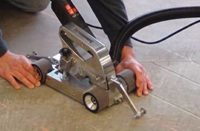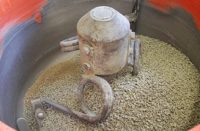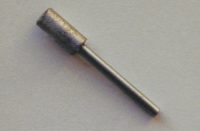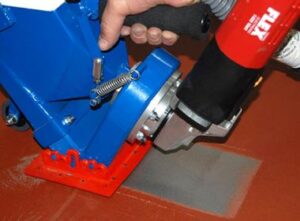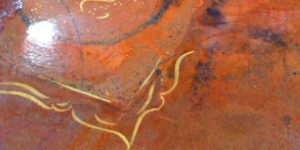A shot blaster is the tool of choice for concrete contractors when prepping a surface. Shot blasting gives the surface a rough profile so coatings and sealers will bond snugly with a floor.
A shot blaster fire scores of tiny BB’s at the ground over and over again. It duplicates a simple mechanical action — a metal object hitting a crushable piece of material — and duplicates it very, very quickly. If you want to tear a layer off a slab of concrete, these machines will certainly do the job.
But shot blasters have the same downside as shotguns: The end result is not exactly tidy.
That’s not a problem if you’re prepping a new warehouse floor for a thick layer of epoxy. But for decorative concrete contractors who shot blast, the questions “why,” “when,” and “how” are much more crucial.
A shot blaster is the tool of choice for concrete contractors when prepping a surface, says Greg Ferchaud, national sales manager for SASE Co. Inc., which distributes Italian-made Trimmer shot blasters. Shot blasting gives the surface a rough profile so coatings and sealers will bond snugly with a floor. “You scarify, diamond grind or shot blast — that’s how you prep a floor,” he says. “Shot blasting requires the most attention of the three. It can be the most productive, but it requires the most parts to be replaced.”
Shot blasters were developed to scour nonskid coatings off the steel decks of aircraft carriers. When it comes to concrete, most shot blasters are used on large industrial and commercial jobs, from cleaning parking lots to scouring line stripes off highways. “To come into a residential home and use a shot blaster is pretty rare,” Ferchaud says.
But small-job contractors use them too. The rough profile guarantees a good bond, and the work can be done in a fraction of the time it can take with other equipment.
Shot blasters can be used to blast decorative garage floors before coating. On new construction sites, they can scrape the dusty top surface off rained-on concrete. They have even been used to stencil patterns, from company logos to leaves and seashells, on concrete.
Shot blasting is essential before applying an overlay, says Dave Pettigrew of Diamond D Concrete. “Some manufacturers won’t even warranty their product without blasting,” Pettigrew says. “You have to give the existing concrete a tooth so you can attach to it.”
Give it a shot
Trevor Risher’s Seattle-based outfit, Washington Shotblasting, shoots five million square feet a year, much of it as a sub for small or mid-size contractors. “I have different shot blasters for different types of jobs,” he says.
A good machine costs $30,000, he says, so if a contractor only blasts one job a year, it may be more cost-effective to hire a specialist like himself. But he acknowledges he occasionally loses good clients when they finally decide to buy their own machines.
Let’s say you’ve reached that point — you expect to use a shot blaster on at least four or five jobs a year, so buying one makes sense. How do you go about shopping for one?
Bruce Williams, owner of B W Manufacturing Inc., based in Grand Rapids, Mich., says shoppers should look at reliability, production rate, and ease of maintenance and servicing. “A lot of times what I do is refer people to owners of the equipment,” he says.
Allen Slater, product specialist with Blastrac, a leading manufacturer of shot blasters, says five variables impact each blasting project: the travel speed of the propulsion device; the quantity and size of the abrasive; the tenacity of the coating to be removed; the desired end result; and the size of the machine.
However, he says, the most important question is a basic one: How many square feet of production do you need per hour?
 Machines with blast widths between 10 inches to 30 inches will cost roughly the same, he says, but below 10 inches, the price drips drastically.
Machines with blast widths between 10 inches to 30 inches will cost roughly the same, he says, but below 10 inches, the price drips drastically.
A shot blaster is the tool of choice for concrete contractors when prepping a surface. Shot blasting gives the surface a rough profile so coatings and sealers will bond snugly with a floor.
The first shot blaster you buy should be small, for edges, corners, tight spots and test patches, he says. “You have to have the small one. Even if you have a 30-inch, how are you going to get in and do restroom stalls?”
Another variable is the way the shot is propelled out of the machine. Most machines are “center-fed,” meaning the abrasive flows into the center of a centrifugal wheel. But some big riding models are “paddle-fed,” in which the shot is fed onto a wheel peripherally. Paddle-fed models work best with medium-size to large pieces of shot, but they throw with less velocity than a center-fed wheel, so they distribute a more even shot pattern.
“They deliver a more even profile than center-fed,” says Williams, whose company makes a paddle-fed machine. “Center-fed machines leave you with lots of hot spots. A lot of times they hit harder on one side than the other.”
The shot itself is almost always steel and round, but it varies in size. Pieces typically used in blasting range between 17 thousandths of an inch (S-170) and 46 thousands of an inch (S-460) in diameter. The size of the abrasive dictates how much energy or force it exerts, and bigger shot will do more damage in a smaller period of time.
Today’s diamond grinders provide fierce competition for shot blasters, Ferchaud says. They are so powerful that they don’t require a shot blast before polishing, and they prep a floor quickly. “Diamond grinders have put a big dent in the shot blaster business,” he says. “It’s just the latest way of doing it and it’s better in a lot of applications.”
But shot blasters have advantages over diamond grinders. For one thing, given two machines of the same size, the shot blaster will be faster, Ferchaud says.
While diamond grinding can clean a surface, it doesn’t open pores like a shot blaster, Williams says. “The pores allow the material to soak down into the concrete further and give you a better blending surface.”
Risher of Washington Shotblasting says diamond grinding can replace shot blasting on some jobs, like prepping for stains. But when prepping for overlays and coatings, it’s a poor substitute, he says. “Diamond grinding leaves too smooth a surface to have a mechanical bond. It will fail faster. Most coating manufacturers will recommend shot blasting. The biggest concern they have is adhesion.”
Problems to watch for
The shot blaster is easy to use compared to other machines in decorative concrete, Williams says. “It’s really self-explanatory. I sell to guys who are just getting into the business all the time. They actually love the machine. Once you’ve done it one or two times, you’ll know what you’re doing within reason.”
But problems crop up quickly. For starters, the machine leaves “tiger stripes” or “cornrows” when rows overlap, and those can be tough to cover up if you only intend to lay down a light coating.
Just turning on the machine without thinking can damage a floor. If you go over your surface too quickly, you leave stuff behind. Too slow, and you remove too much. (Start with small shot and run the machine quickly, Risher advises, slowing down or switching to bigger shot as needed.)
Thicker epoxies are harder to blast through. And shot will just bounce off elastomeric or rubberized coatings.
Urethane coatings will transmit the energy of the blast to the concrete underneath, crushing it. Then the top just peels away. But the peelings can clog the screen in the hopper of the machine.
Adhesive coatings and glues will also cause problems for shot blasters. The machines create frictional heat, and that heat can make an adhesive sticky again, gumming up the shot inside the machine. “Once shot sticks to anything, shot sticks to shot, and then you have to dump the whole load,” Ferchaud says. “If they don’t hit something hard enough to rebound, they just die.”
A shot blaster will also be less effective if used on a floor that has been blasted before. You can end up with a very rough profile. “If a floor was well-prepped prior to coating, the coating is tougher to get off,” Slater says.
For all these reasons, training and support for novices is critical. “I don’t sell a shot blaster without training unless they’re buying their second machine,” Ferchaud says. “If there’s any piece of equipment you need training on, it’s a shot blaster.”
Shot blasters must also master a number of variables in terms of electronics, environment and upkeep. “Shot blasters are very high-maintenance,” Ferchaud says. “A shot blaster is a self-destructing piece of equipment. All that abrasive stuff is constantly going through the machine.”
Slater agrees. “To get consistent results, you need to consistently maintain the machine,” he says.
